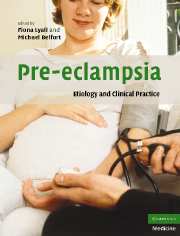Book contents
- Frontmatter
- Contents
- List of contributors
- Preface
- Part I Basic science
- 1 Trophoblast invasion in pre-eclampsia and other pregnancy disorders
- 2 Development of the utero-placental circulation: purported mechanisms for cytotrophoblast invasion in normal pregnancy and pre-eclampsia
- 3 In vitro models for studying pre-eclampsia
- 4 Endothelial factors
- 5 The renin–angiotensin system in pre-eclampsia
- 6 Immunological factors and placentation: implications for pre-eclampsia
- 7 Immunological factors and placentation: implications for pre-eclampsia
- 8 The role of oxidative stress in pre-eclampsia
- 9 Placental hypoxia, hyperoxia and ischemia–reperfusion injury in pre-eclampsia
- 10 Tenney–Parker changes and apoptotic versus necrotic shedding of trophoblast in normal pregnancy and pre-eclampsia
- 11 Dyslipidemia and pre-eclampsia
- 12 Pre-eclampsia a two-stage disorder: what is the linkage? Are there directed fetal/placental signals?
- 13 High altitude and pre-eclampsia
- 14 The use of mouse models to explore fetal–maternal interactions underlying pre-eclampsia
- 15 Prediction of pre-eclampsia
- 16 Long-term implications of pre-eclampsia for maternal health
- Part II Clinical Practice
- Subject index
- References
14 - The use of mouse models to explore fetal–maternal interactions underlying pre-eclampsia
from Part I - Basic science
Published online by Cambridge University Press: 03 September 2009
- Frontmatter
- Contents
- List of contributors
- Preface
- Part I Basic science
- 1 Trophoblast invasion in pre-eclampsia and other pregnancy disorders
- 2 Development of the utero-placental circulation: purported mechanisms for cytotrophoblast invasion in normal pregnancy and pre-eclampsia
- 3 In vitro models for studying pre-eclampsia
- 4 Endothelial factors
- 5 The renin–angiotensin system in pre-eclampsia
- 6 Immunological factors and placentation: implications for pre-eclampsia
- 7 Immunological factors and placentation: implications for pre-eclampsia
- 8 The role of oxidative stress in pre-eclampsia
- 9 Placental hypoxia, hyperoxia and ischemia–reperfusion injury in pre-eclampsia
- 10 Tenney–Parker changes and apoptotic versus necrotic shedding of trophoblast in normal pregnancy and pre-eclampsia
- 11 Dyslipidemia and pre-eclampsia
- 12 Pre-eclampsia a two-stage disorder: what is the linkage? Are there directed fetal/placental signals?
- 13 High altitude and pre-eclampsia
- 14 The use of mouse models to explore fetal–maternal interactions underlying pre-eclampsia
- 15 Prediction of pre-eclampsia
- 16 Long-term implications of pre-eclampsia for maternal health
- Part II Clinical Practice
- Subject index
- References
Summary
While the disease has been studied for decades, the pathogenesis of pre-eclampsia remains mysterious. However, studies of the disease in humans are confounded by the fact that while the disease manifests in the second and third trimester its origins likely begin in the first trimester (Cross, 1996; Roberts and Cooper, 2001; Roberts and Lain, 2002). This makes defining both the etiology and the subsequent pathological events rather difficult, and researchers are limited to making inferences from pathological specimens, and distinguishing between primary and secondary events can be impossible. Despite these challenges, the fact that pre-eclampsia is strictly a disease of pregnancy indicates that the fetus and/or placenta interact with maternal factors to produce the disease. Indeed, several lines of evidence support the idea that placental development and/or function are abnormal in pre-eclampsia (Cross, 1996; Roberts and Cooper, 2001; Roberts and Lain, 2002). The strict requirement for a fetal–maternal interaction has led to the hypothesis that both feto-placental defects and maternal susceptibility to hypertensive and/or renal disease are required in order to initiate the disease (Cross, 1996; Lachmeijer et al., 2002; Roberts and Cooper, 2001; Roberts and Lain, 2002). However, as reviewed here, emerging evidence from mouse and rat models shows that pre-eclampsia can be initiated by multiple means, each producing all of the pathognomonic features of the disease – gestational hypertension, proteinuria and renal glomerular lesions (Davisson et al., 2002; Faas et al., 1995; Kanayama et al., 2002; Maynard et al., 2003; Sakawi et al., 2000; Wardle, 1976).
- Type
- Chapter
- Information
- Pre-eclampsiaEtiology and Clinical Practice, pp. 209 - 214Publisher: Cambridge University PressPrint publication year: 2007



